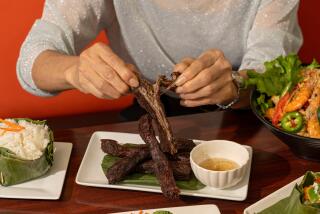Cambodian Villagers Shift to Clean Energy
- Share via
TAMOUNG, Cambodia — Nget Loun’s rickety old thatched house is typical of Cambodia’s impoverished countryside, but it holds a surprise inside: a state-of-the-art, environmentally friendly gas stove.
Off the power grid, her household and 29 others in this village get a steady supply of clean energy from human and animal waste, using a device that not only makes cooking less of a chore, but also keeps their gardens flourishing and helps save the forests.
At the center of the experiment is a device called a biological gas digester -- or biodigester -- that converts a byproduct of manure into cooking gas.
The technology has taken hold in other countries as a way to generate gas or electricity, and now an independent development group is hoping to spread it to Cambodia’s poor rural people.
Brendan Boucher, Australian coordinator for the nonprofit Cambodian Rural Development Team, which is financed by donations from abroad, introduced the project last year in Tamoung, 45 miles south of Phnom Penh.
Boucher says biogas stoves can help improve food security for villagers and reduce the pressures on Cambodia’s fast-disappearing forests, which are relied on for firewood.
Som Chhear, 57, says he used to trek 6 miles from home to find firewood to store for use during the rainy season. When his supply ran low, he had to buy firewood or charcoal.
Now his biodigester provides him with free cooking gas and nutrient-rich organic fertilizer that “keeps my vegetable garden green for all seasons.”
Nget Loun, 25, says the biogas stove makes it easier to cook. “The cooking pots and my hands are no longer dirtied with black smoke” from burning wood, she says. “And it has absolutely no smell.”
Boucher notes another benefit: the introduction of toilets, a hygienic convenience absent from most rural homes.
Human and animal waste is flushed through the toilet into a plastic “digester” tube 33 feet long and 1.6 feet in diameter that sits in a ditch under a thatched roof. At the far end, a knee-deep trench collects liquid residue for use as fertilizer. A PVC pipe attached to the tube’s midsection channels methane gas emitted by the manure mix into a plastic storage bag in the house, from which it is fed into the stove. Each unit costs about $100.
Boucher says biogas units are part of an integrated development package of water wells, fish ponds, vegetable gardens and training in farming methods, all meant to bolster food security.
About half of Cambodia’s 13 million people live on less than a dollar a day.
The Australian government paid $13,511 for the package for Tamoung village.
Twenty-five biodigesters were installed to serve 30 of the village’s 130 families. Ownership of at least three cows was a prerequisite -- making 100 families eligible -- and a drawing selected those who got the systems.
Previous efforts to promote biogas technology in Cambodia more than a decade ago met with limited success. About 500 biogas units were installed but most were abandoned by users within one or two years, said San Thy, a researcher at the Center for Livestock and Agriculture Development, another nonprofit group.
One reason was that peasants failed to keep a suitable number of livestock.
“Sometimes, needing money, they just sold their entire stock. Without supplies of manure, the digesters simply don’t work,” San Thy said.
Boucher says that providing villages with integrated systems that include components for sustainable development -- such as ponds and gardens -- can generate income to pay for maintenance of the biodigesters.
It has been a boon for Chent Dejorith’s family, which raises pigs. He says his brother-in-law uses the methane gas to power a small generator, which pumps water from their well to sell to other villagers.
“Sometimes, we even use the power from the generator to operate our karaoke machine and sing for fun,” he said.
More to Read
Sign up for Essential California
The most important California stories and recommendations in your inbox every morning.
You may occasionally receive promotional content from the Los Angeles Times.












